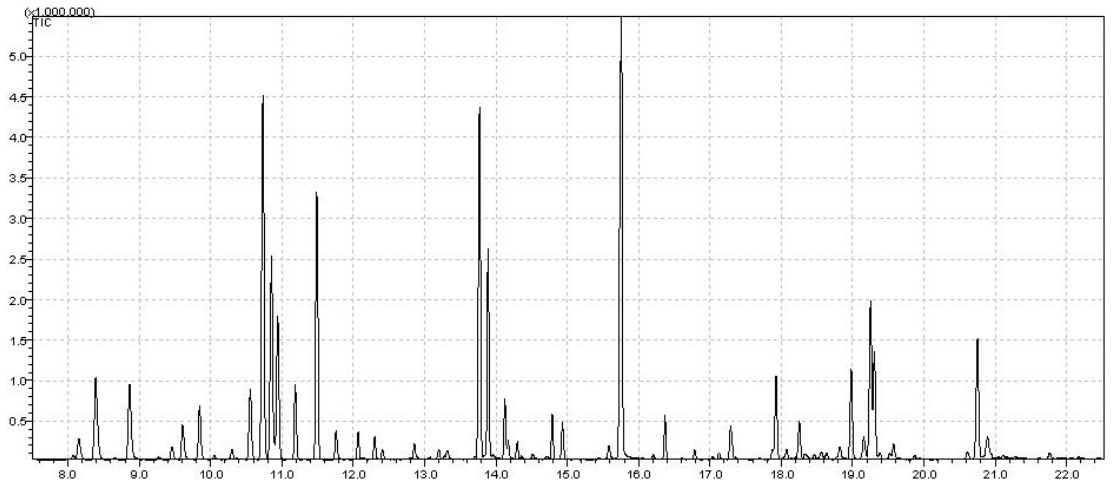COMPONENT COMPOSITION OF ESSENTIAL OIL OF SATUREJA SUBDENTATA BOISS. FROM NATURAL AND INTRODUCTION POPULATIONS OF THE FLORA DAGESTAN
Abstract
The taxonomic position of investigated species and its fragmented habitat together with polymorphic species within its natural propagation is of interest to study the variability of the trends on the component composition of essential oils along environmental gradients.
Based on the fact that Dagestan is part of the areal of this species previously to not been studied for the composition of the essential oil componentthe aims of the present study was to gain an understanding of the component of essential oil of a "typical" population Satureja subdentata Boiss. from the middle mountains.
The essential oil isolated from the aerial parts of S. subdentata by hydrodistillation was analyzed by GC-MS. Fifty three were identified from of total sixty one compounds.
Thus, the observed reduction of monoterpenes and derivatives thereof and sesquiterpenes and derivatives thereof increase when compared with the natural sample (Kuppinskу Pass,1000 m above sea level) with their samples to Gunibsky (1730 m above sea level) and Tsudaharsky (1100 m above sea level) experimental base. Noted differently directed action of altitude of raw material gathering places on above sea level on quantitative content of individual essential oil components.
Downloads
Metrics
References
Hegi G. Illustrierte Flora von Mitteleuropa. 1964. Vol. 4(3). Pp. 2306–2327.
Войткевич С.А. Эфирные масла для парфюмерии и ароматерапии. М., 1999. 329 с.
Davis P.H. Flora of Turkey and East Aegean Islands, Edinburg: University Press, 1982. 947 p.
Муртазалиев Р.А. Конспект флоры Дагестана. Т.III. Махачкала, 2009. 304 с.
Satil F., Dirmenii T., Tümen G. Natural situation of commercial Satureja species in Turkey // 16 National Congress of Biology (September 1–7, 2002). Malatya, Turkey, 2002. Pp. 120–126.
Гладышева О.В., Олейникова Е.М. Онтогенез и семенная продуктивность вида Satureja montana L. при интро-дукции в ЦЧР // Вестник Воронежского государственного аграрного университета. 2014. №3 (42). С. 35–40.
Горлачева З.С. Особенности онтогенеза Satureja montana L. Subsp. montana и Satureja montana L. Subsp. Varie-gata (Host) Bell. В условиях степной зоны Украины // Промышленная ботаника. 2013. Вып. 13. C. 280–287.
Железняк Т.Г., Ворнику З.Н., Тимчук К.С. Чабер горный – источник биологически активных веществ // Биоло-гически активные вещества растений – изучение и использование : материалы Международной научной конфе-ренции 29–31 мая 2013 г. Минск, 2013. С. 98–99.
de Oliveira Th.L., de Araújo Soares R., Ramos E.M. et al. Antimicrobial activity of Satureja montana L. essential oil against Clostridium perfringens type A inoculated in mortadella-type sausages formulated with different levels of sodi-um nitrite // International Journal of Food Microbiology. 2011. Vol. 144. Pp. 546–555.
Mihajilov-Krstev T., Radnović D., Kitić D. et al. Chemical composition, antimicrobial, antioxidative and anticholinester-ase activity of Satureja montana L. ssp montana essential oil // Cent. Eur. J. Biol. 2014. Vol. 9. N7. Pp. 668–677.
Палий А.Е., Хлыпенко Л.А. Летучие соединения водно-этанольного экстракта Satureja montana L. // Фармация и фармакология. 2014. №6 (7). С. 22–24.
Svoboda К.Р., Hay R.K.M., Waterman P.G. Growing summer savory (Satureja hortensis) in Scotland: Quantitative and qualitative analysis of the volatile oil and factors influencing oil production // Journal of the Science of Food and Agri-culture. 1990. Vol. 53. N2. Pp. 193–202.
Müller K., Riebau F., Berger B., Yegen O. Chemical Composition and Fungitoxic Properties to Phytopathogenetic Fun-gi of Essential Oils of Selected Aromatic Plants Growing in Turkey // J. Agric. Food Chem. 1995. N43. Pp. 2262–2266.
Во Тхингок Х.А., Джалилов Ф.С. Антибактериальная активность эфирных масел и их использование для обез-зараживания семян капусты от сосудистого бактериоза // Известия ТСХА. 2014. Вып. 6. С. 59–68.
Зубарев А.В., Спиридович Е.В. Использование эфирных масел растений для профилактики шистосомного церкариоза // Биологически активные вещества растений – изучение и использование : материалы Международ-ной научной конференции 29–31 мая 2013 г. Минск, 2013. С. 102–103.
Вагабова Ф.А., Мусаев А.М., Алибегова А.Н, Раджабов Г.К., Гасанов Р.З., Гусейнова З.А. Изучение суммар-ного содержания флавоноидов и антиоксидантной активности надземной части Saturea subdentata Boiss., произ-растающей в условиях Дагестана // Фундаментальные исследования. 2013. №4-1. С. 103–107.
Государственная Фармакопея СССР. Общие методы анализа. Лекарственное растительное сырье. М., 1989. 400 с.
Adams R. Essential Oil Components by Quadrupole GC/MS, Allured Publishing Corp., Carol Stream, IL. 2001.
Aliev A.M., Radjabov G.K., Musaev A.M. Dynamics of supercritical extraction of biological active substances from the Juniperus communis var. Saxatillis // The Journal of Supercritical Fluids. 2015. Vol. 102. Pp. 66–72.
Aliev A.M., Radjabov G.K., Stepanov G.V. Component fnflysis of supercritical CO2 extract of Juniperus oblonga M.-Bieb fruits // Russian Journal of Physical Chemistry B. 2013. Vol. 7. N7. Pp. 795–801.
Королюк Е.А., Ткачёв А.В. Химический состав эфирного масла двух видов полыни: Artemisia frigida и Artemi-sia argyrophylla // Химия растительного сырья. 2009. №4. С. 63–72.
Ткачев А.В. Исследование летучих веществ растений. Новосибирск, 2008. 969 с.


This work is licensed under a Creative Commons Attribution 4.0 International License.
The authors, which are published in this journal, agree to the following conditions:
1. Authors retain the copyright to the work and transfer to the journal the right of the first publication along with the work, at the same time licensing it under the terms of the Creative Commons Attribution License, which allows others to distribute this work with the obligatory indication of the authorship of this work and a link to the original publication in this journal .
2. The authors retain the right to enter into separate, additional contractual agreements for the non-exclusive distribution of the version of the work published by this journal (for example, to place it in the university depository or to publish it in a book), with reference to the original publication in this journal.
3. Authors are allowed to post their work on the Internet (for example, in a university repository or on their personal website) before and during the review process of this journal, as this may lead to a productive discussion, as well as more links to this published work.











